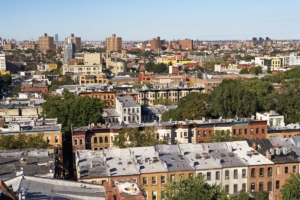Sales inventory reached new highs across the city over the last quarter, leading to a record number of homes offering price cuts in Manhattan and Brooklyn. The share of homes with a price cut rose in every submarket across the city, led by the Upper East Side [i], where one in three homes for sale received a price cut, according to the Q2 2018 StreetEasy Market Reports [ii].
Amid higher inventory, sales prices started to cool. The StreetEasy Price Index [iii] fell 1.1 percent in Manhattan to $1,160,419 and stagnated in Brooklyn at $724,733. This drop in Manhattan home prices is the largest year-over-year decrease since the financial crisis [iv]. Queens prices bucked this trend, increasing 7.3 percent to $530,556 — the highest level on record.
“The dynamics of the city’s real estate market have favored renting over buying for some time now, though the tide may be starting to turn,” says StreetEasy Senior Economist Grant Long. “New Yorkers with the means for a down payment now have more options to choose from than at any point in the past seven years — and this trend isn’t just contained at the high-end, where we’ve been seeing rising inventory for several years now. Heading into the fall, buyers are in a strong position to strike a deal and can afford to shop around, wait for the right home, and negotiate aggressively.”
Q2 2018 Key Findings — Manhattan
- Inventory reached the highest level since 2011. Sales inventory in Manhattan increased 15.2 percent since last year. Inventory rose in every Manhattan neighborhood except one: in Hamilton Heights, it dropped by 11.8 percent from last year.
- The number of homes offering discounts reached an all-time high. More than one in four homes for sale (28 percent) in Manhattan received a price cut in Q2, an increase of 5.3 percent over last year.
- The Upper East Side was the only submarket where prices rose. Upper East Side home prices increased 3 percent to $1,058,121. Prices dropped in every other submarket; in Midtown, they dipped to 2016 levels, falling 3.3 percent from last year to $1,206,268.
- Rents reached an all-time high. Rents rose in all five Manhattan submarkets, led by Upper Manhattan, where they increased 3.1 percent to $2,352. Manhattan rents grew 1.5 percent year-over-year, hitting a record high of $3,212 [v].
- The number of rentals offering a discount hit its lowest level since 2015. 20 percent of Manhattan rentals were discounted in the second quarter, a decrease of 4.6 percentage points from last year.
Q2 2018 Key Findings — Brooklyn
- The number of homes for sale hit an all-time high. Sales inventory in the borough rose 24.4 percent over last year. Inventory rose in every Brooklyn submarket except North Brooklyn, where it fell 3.1 percent.
- Price cuts rose to an all-time high. The share of sales with a price cut reached an all-time high of 21 percent, up 3.7 percentage points from the second quarter of 2017.
- Prices stagnated across the borough, except for North Brooklyn. The StreetEasy Brooklyn Price Index dipped 0.5 percent to $724,733. Prices in North Brooklyn reached new highs: up 6 percent since last year to $1,172,770.
- North Brooklyn homes came off the market two weeks faster. Homes in North Brooklyn sold after a median of 55 days — 18 days faster than last year. Across the borough, homes stayed on the market for a median of 53 days, one day longer than last year.
- Rents reach an all-time high. The StreetEasy Brooklyn Rent Index increased 1.4 percent year-over-year to an all-time high of $2,588. North Brooklyn was the only submarket where rents stagnated, likely because of the L train shutdown, at $3,067.
Q2 2018 Key Findings — Queens
- The amount of for-sale inventory rose. Inventory rose 19 percent across the borough, with significant increases across all five submarkets. South Queens saw the biggest jump in inventory, up 27.1 percent over the second quarter of 2017.
- Despite rising prices, price cuts also rose. The share of Queens homes offering price cuts rose 17.4 percent, up 5.9 percentage points over last year. In Northwest Queens, more than one in four listings had their prices cut, up 11.1 percent since last year.
- Queens was the only borough where prices rose. Prices rose 7.3 percent in Queens to $530,556, the highest level on record.
- Homes in South Queens came off the market nearly two weeks faster. South Queens homes sold 12 days faster than last year, reaching a median of 50 days on the market.
- Rents remained flat, except in Central Queens. The StreetEasy Queens Rent Index stagnated at $2,140. Rents in Central Queens rose 2.3 percent year-over-year, to a median of $2,083.
- One in five rentals were discounted. 20 percent of Queens rentals offered discounts, roughly the same amount as last year. The share of discounted rentals rose the most in the Rockaways: 16.5 percent were discounted, up 6.5 percentage points year-over-year.
The complete StreetEasy Market Reports for Manhattan, Brooklyn and Queens, with additional neighborhood data and graphics, can be viewed here. Definitions of StreetEasy’s metrics and monthly data from each report are available here.
[i] The Upper East Side submarket includes Lenox Hill, Yorkville, Carnegie Hill, Upper Carnegie Hill and Upper East Side neighborhoods.
[ii] The StreetEasy Market Reports are a monthly overview of the Manhattan, Brooklyn and Queens sales and rental markets. Every three months, a quarterly analysis is published. The report data is aggregated from public recorded sales and listings data from real estate brokerages that provide comprehensive coverage of Manhattan, Brooklyn and Queens, with more than a decade of history for most metrics. The reports are compiled by the StreetEasy Research team. See here for more information. StreetEasy tracks data for all five boroughs within New York City, but currently only produces reports for Manhattan, Brooklyn and Queens.
[iii] The StreetEasy Price Indices track changes in resale prices of condo, co-op, and townhouse units. Each index uses a repeat-sales method of comparing the sales prices of the same properties since January 1995 in Manhattan and January 2007 in Brooklyn and Queens. Given this methodology, each index accurately captures the change in home prices by controlling for the varying composition of homes sold in a given month. Levels of the StreetEasy Price Indices reflect average values of homes on the market. Data on the sale of homes is sourced from the New York City Department of Finance. Full methodology here.
[iv] The StreetEasy Manhattan Price Index was down 2.3 percentage points year-over-year in May 2010
[v] StreetEasy has tracked annual changes in the Manhattan Rent Index since 2011.
—
Hey, why not like StreetEasy on Facebook and follow @streeteasy on Instagram?










